Basic Facts
- The Ottomans are one of the greatest and most powerful civilizations of the modern world” (Hooker, 1996, para.1)
- The moment of glory” – the sixteenth century.
- Islamic Empire. “The largest and most influential of the Muslim empires” (Hooker, 1996, papa.2).
- Period of Existence: 1299-November 1, 1922.
Richard Hooker (1996) calls the Ottomans “one of the greatest and most powerful civilizations of the modern world” (para.1). The researcher stresses the importance of “the moment of glory” that was in the sixteenth century and it was the time when the Ottoman Empire was the perfect example of “human creativity, optimism, and artistry” (Hooker, 1996, para.1).
In fact, the Ottoman Empire had the ground for boasting. It was an Islamic empire that was rightfully called “the largest and the most influential of the Muslim empires of the Modern period” (Hooker, 1996, para.2).
As for the whole period of the existence of the Ottoman Empire, it covered seven centuries from 1299 to 1922.
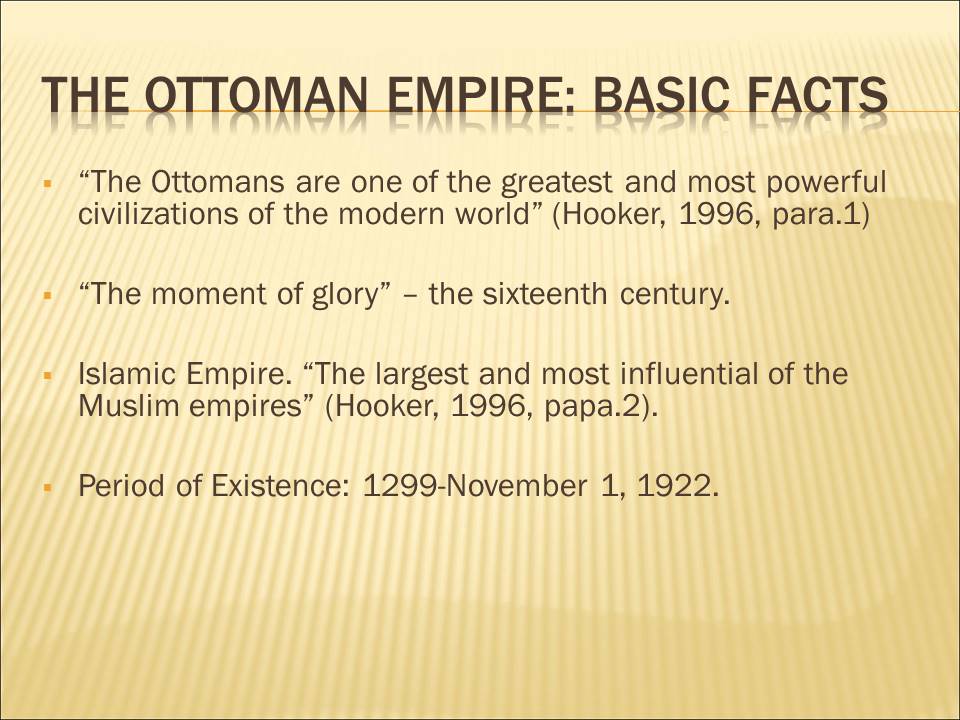
The Territory of the Ottoman Empire
The whole territory captured and controlled by the Ottoman Empire during the military campaigns they undertook included Western Asia, southeastern European regions, as well as large territories of Eastern Europe, Anatolia (modern Turkey), the Caucuses, and the territories in Middle East to Iran. The Northern regions of Africa also belonged to the territory of the Ottoman Empire.
Thus, it is possible to state that during the age of expansion and prosperity, the Ottoman Empire set its power on three continents at the same time.
It is evident that it was a very hard task to establish strict and continuous control over such a vast territory and this was one of the main factors that caused rebellious mood of the peoples who belonged to the Ottoman Empire due to its military victories, but not traditionally . The center of the Ottoman Empire was in Anatolia, the control over other regions was the result of the policy of aggressive expansion.
Due to a number of regions that were traditionally alien to Anatolia in many aspects (for example, religion as the Ottoman Empire included religiously diverse regions, suck as Christian), even the Golden Age, the period of rise of the Empire can be characterized by internal conflicts that resulted in rebellions against the Empire.
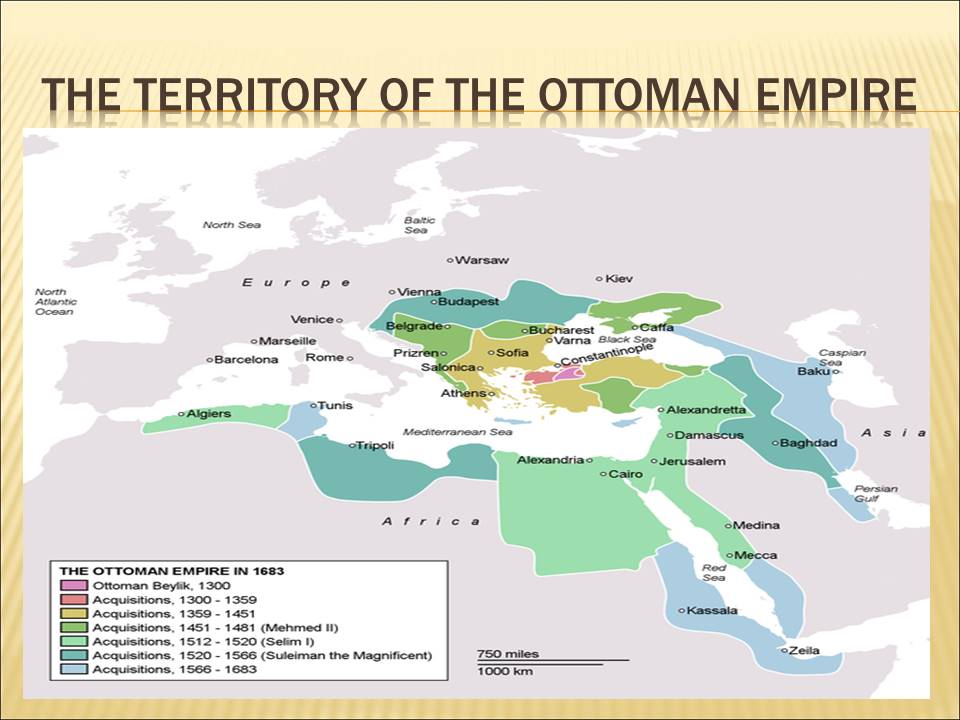
The Rebellions During the Age of Rise of the Ottoman Empire
The revolt lead by Sheikh Bedrettin (Bedreddin): 1416.
Reasons:
- Military reason: The Battle of Ankara
- Political reason: Fratricide between the sultans.
- Social reasons:
- taxation
- exploitation of people
Sheikh Bedrettin, or Bedrettin was a prominent figure in the history of the Ottoman Empire of the fifteenth century as he was the person who organized and lead the most significant internal revolt of that century. There were several reasons and circumstances that in complex created a favorable ground for his revolt.
The Battle of Ankara of 1402 brought defeat to Bayazid who was captured and died in captivity. An interesting idea was offered by Singh (2000) who said that the end of this battle “paved the way to the rise of Europe” (p.11). As the result of Bayazid’s defeat, there started a fratricide between the sultans, it became impossible to rule and govern the Empire accordingly. The sultans were trying to capture power and their attempts were so violent that the cases of fratricide became common.
Since the sultans had no time to take care of the well-being of the people and the Empire, the people suffered from enormous taxes imposed on them by the central Ottoman government and local representatives of the government were strict in the matter of tax extraction from the exploited people.
Since common people were deprived of land, Sheikh Bedrettin wanted to stop their exploitation by with the help of the division of land among all citizens. However, the revolt was suppressed and the leader and his companion were crucified and hung.

The Revolts During the 16th-17th Centuries
The Serb Uprising in Banat, 1594.
The Holy War
Reasons:
- Taxation pressure
- Plundering of the monasteries
- Religious pressure
- Noblemen wanted to get their privileges back (Circovic, 2004).
The notion of “the Holy War” presupposes that the main reasons for the war have religious nature, people who start such a war are either trying to protect their own religion or impose it on the other people.
On the whole, the nature of the Serb uprising in Banat in 1594 corresponded to the definition of the Holy War. A bright fact is that the Serbs struggled under the flags that had the image of Saint Sava (that can be seen in the picture). If the main reason for Bedrettdin’s revolt was tax pressure of the people, it also remained among the reason for this very rebellion since Serbian people were under great taxation pressure imposed by the Ottoman Empire.
Besides, the list of reasons for the rebellion was extended by religious pressure that the Orthodox Serbian church suffered from the Muslim Ottomans. Among the main claims of the chieftains were that the Turks had to give back everything they had seized from the Serbian monasteries and let them retain their revenues again.
Also, the chieftains of the revolt were noblemen, they wanted to get their estates, privileges, titles back (Circovik, 2004). This shows that all social layers of the conquered Serbian people were under pressure and this was the reason why they disapproved of the Ottoman rule.
Jelali Revolts
- Place: Anatolia
- The rebels – Turkmen clans
- Participants: sekbans, sipahis.
Reasons:
- Social and economic crisis
- Depreciation of currency
- Heavy taxation
- Decline in the devsirme system
- Admission of Muslims into the army
- Increase of the Janissaries (Encyclopedia Britannica, 2002, p.525).
Jelali revolts started when the Ottoman Empire started to lose its authority gradually. This process started in the 16th century. It took place in Anatolia, the rightful territory of the Ottoman Empire, not the one they captured. As for the rebels, they were the Turkmen clans that feat that they were deprived of influence on their land.
The relolts based on “the sekbans” that were irregular troops of musketeers and “the sipahis” – the cavalrymen that were maintained by land grants (Encyclopedia Britannica, 2002, p.525). It is necessary to mention that the people who took part in the revolts had no intention to attack the government of the Ottoman Empire. Instead, the people decided to take aggressive measure because they were not satisfied with economic situation in the Empire.
Such factors as depreciation of national currency, heavy taxes impose on the peasant population and bad living conditions that were their results caused unrest and people’s dissatisfaction with life they lead.
Decline in the devsirme system that was levy of the young men and boys that came from Christian families and the increase of admission of Islamic men into the army also contributed to unrest of the Turkmen clans and Kurdish nomands (Encyclopedia Britannica, 2002, p.525).
The increase of the Janissaries, elite troops, which can be seen in the picture, was one more reason for the revolt. These troops were very important and prestigious in the Ottoman Empire and it turned out that they could even influence the government. Also, Janissaries used their power and influence to make themselves richer as they could become landlords and own vast lands as well as took part in trade and became well-off people. All these factors caused Jelali revolts.
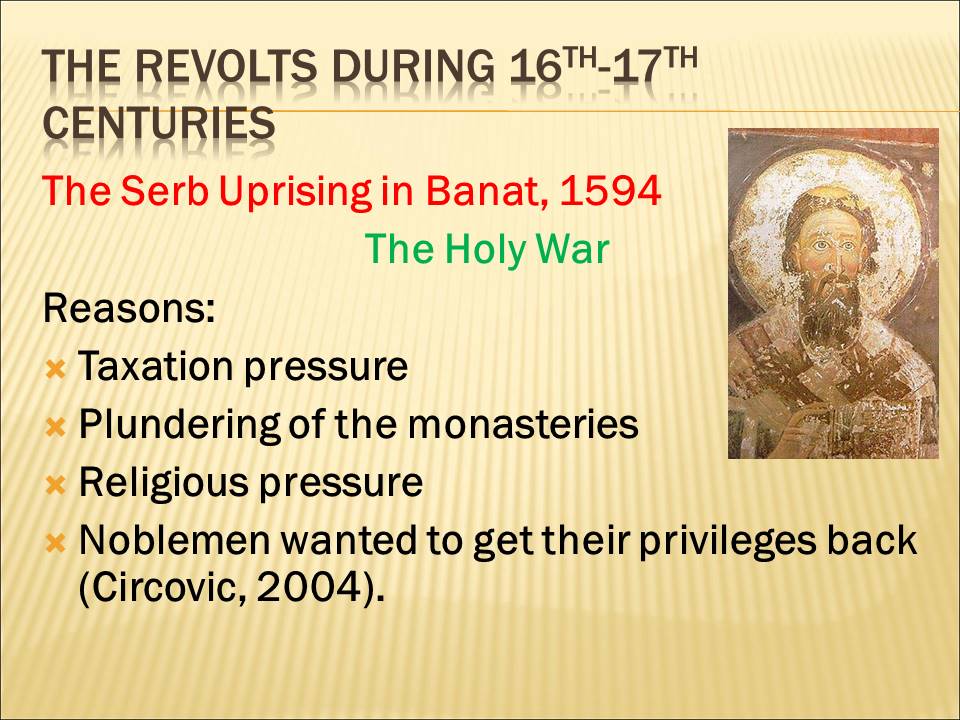
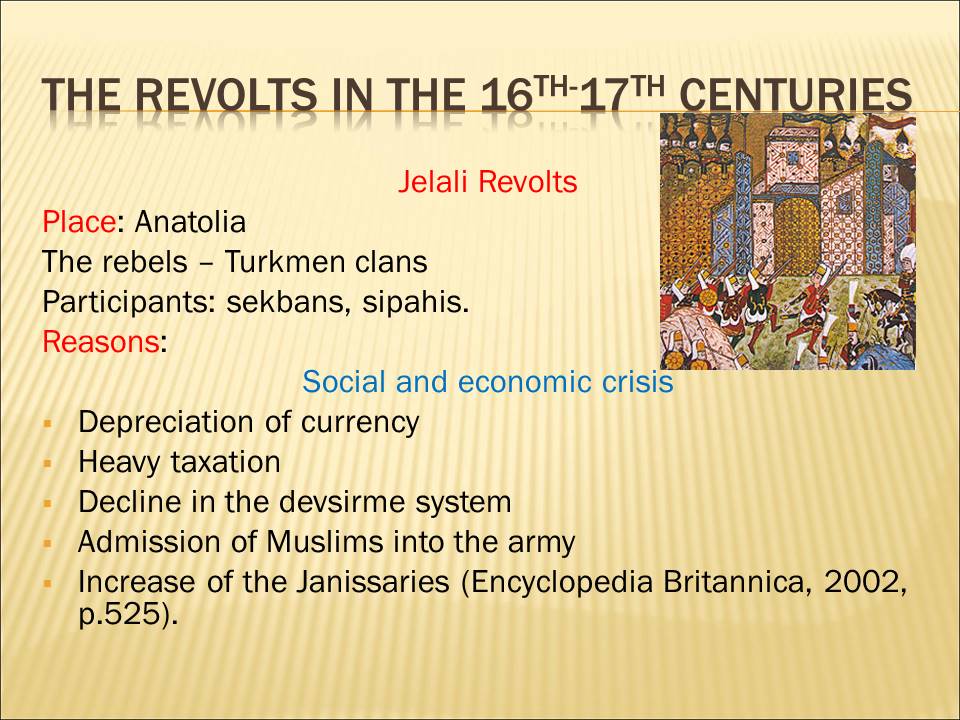
Internal Rebellions in the 19th Century
Serbian Revolution (1804-1835)
Main Events:
- The First Serbian Uprising
- Second Serbian Uprising
- Recognition of Serbian State
Serbian Revolution (1804-1835) is a perfect example of resistance of the part of the Ottoman Empire to the rule imposed on the Serbian people. The revolution included three main uprisings: the first Serbian uprising, the Second Serbian Uprising and the Recognition of Serbian State. It is necessary to consider the reasons for these two main revolts during the time of the Ottoman occupation of Serbia.

The First Serbian Uprising
General reason: “The desire for national emancipation” (Trbovich, 2008, p.67).
Concrete Reasons: False promises
- Proclamation of firmans
- Introduction of knezes
- Freedoms: religion and trade.
The First Serbian Uprising followed the annexation of Belgrade Pashaluck to the Ottoman Empire as the result of the Austro-Turkish War of 1787-1791.
After 400 years of the Ottoman occupation Serbs started a fight for their rights on their land. A general reason for that was “The desire for national emancipation” (Trbovich, 2008, p.67). However, it is possible to define the concrete reasons for the beginning of the First Serbian Uprising.
Sultan Selim III (that is shown in the picture) promised autonomy to Serbia. He introduced firmans in 1793, 1796 and they granted additional rights to Serbs (Inc Icon Group International, 2008). In addition, the Sultan promised to introduce knezes, which were local rulers inSerbia. Also, freedom of religion and trade was promised to the population of Serbia. However, Selim III was powerless, he was too weak in comparison with the Janissaries who revolted against his rule and acted by their own will. Thus, Serbia did not get what was promised.
Reasons: The Janissaries’ atrocities
- increased taxes
- čitlučenje (labor by force)
- The Slaughter of the Knezes
The Janissaries disobeyed Selim III and invaded Serbia. Again, the factors that provoked the Serb’s revolt were doubled taxes introduced in the country, a new form of oppression of people, called “čitlučenje” that meant forced labor.
However, the final event that turned out to be the factual reason for the revolt was the Slaughter of the Knezes or Dukes that was the massive execution of the Serbian noblemen ordered by the head of the Janissaries.
Karađorđe Petrović was the man who headed the revolt. As for the outcome of the revolt, it cannot be called a successful one, though it created the ground for the Second Serbian Uprising. Besides, Serbia got assistance and support of Russia that helped to put recognition of Serbian state into practice.
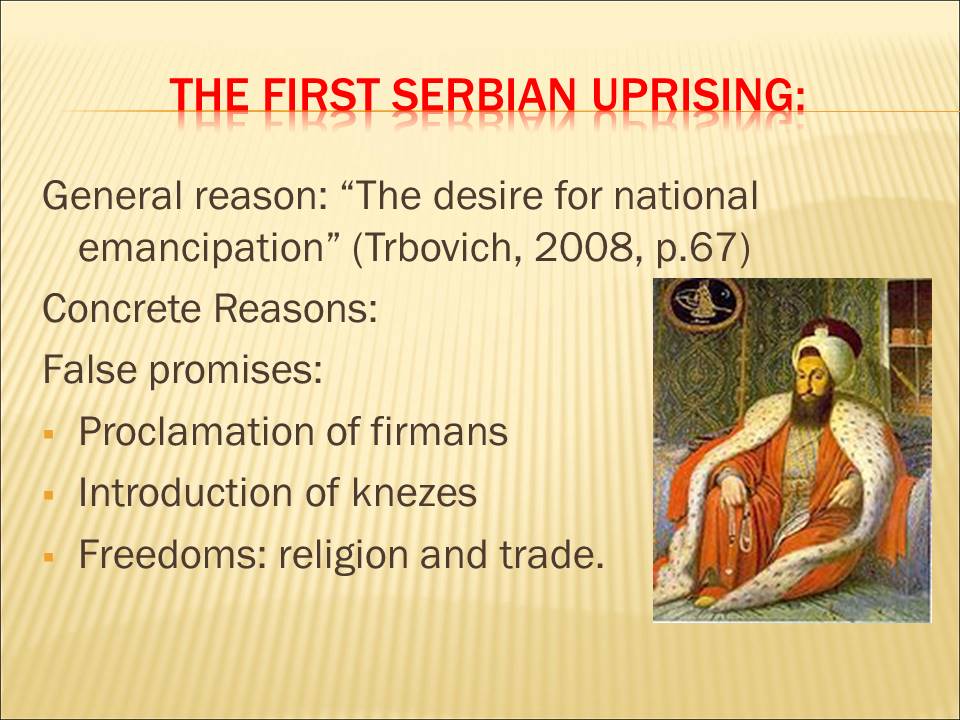

Bosnian Revolt (1831)
Introduction of new reforms:
- Increase of the nizam
- Introduction of new taxes
- The Ottaman bureaucracy
Though according to historic tradition, Bosnia was not a disadvantaged part of the Ottaman Empire, and enjoyed certain privileges in comparison with other European states included into the Empire, the beginning of the nineteenth century turned out to be stressful for Bosnia.
It was the time when Sultan Mahmud II (see the picture on the slide) was in power. The Ottaman Empire experienced awful decline that could be seen by the numerous revolts of that time. Sultan, as the power-bearer, had to take measures. However, these measures turned out to be the reasons for dissatisfaction of the Bosnians. Especially strict were the military reforms, the reforms of the nizam that was the name of the army that was centrally controlled, though new taxes and bureaucracy were also harmful for the Bosnian population.
So, nizam turned out to be the extension of the autocrat’s ideological existence, it gave the rule the opportunity to dominate his subjects by force and extract the funds for the Ottoman rule. Brutal and annihilating tactics of the nizam was outrageous for Bosnian people (Hovannisian, 1992, p.24).

Cretan Insurrection (1866-1869)
Reasons for Insurrection:
- relative freedom,
- mountain regions,
- Christianity.
The outcome: Open way to local administration.
The time of the Cretan uprising covers three years, from 1866 to 1869. It is necessary to mention that among the Ottoman territories Crete was the last of all Greek-speaking regions to be occupied by the Ottomans. It happened in 1669. Due to the landscape of Crete that covered great mountainous territories, it was difficult for the Empire to control them.
As for the reasons for the uprising, this relative freedom due to weak military control of the Ottoman army was one of the reasons for the desire to be free. Those people who lived a free life in the mountains inspired the population that was under the Ottoman Empire to revolt and set themselves free.
The Greek Revolution was one more reason why the people of Crete who were Christians joined Greece in its war of liberation fro the Ottoman oppression. Their main aim was unity with Greece. However, the revolt was suppressed though Turkish government open Cretan Christians the way to local administration of Crete that was a valuable achievement.

Two Epirus Revolts
The First Revolt (1854)
Reasons:
- Military reason: the Crimean War (1854-1856).
- Memories of the recent War of Independence
- Support given by Russia
- Religious motives.
Suppression of the revolt. Greek world that was under the rule of the Ottoman Empire wanted liberation as it was suggested by the Greek War of Independence in 1821-1829.
The middle of the nineteenth century was the perfect time to start a revolt at historic situation favored such actions. The main reason for the revolt was that Russia was in the state of war with the Ottomans and since Russia was a powerful Empire at that time Greeks felt that the War was a chance to get the territory where Greek people lived but the territory did not belong to Greece.
Also, people remembered the help of Russia during the Greek War of Independence and they hoped for such help. Religious motives also inspired the revolt taking into consideration the same religion (Orhtodox) practiced in Russia. Unfortunately, the revolt was doomed due to numerical superiority and British and French support of the Ottoman Empire.

The Second Revolt (1878)
- Reason for its breaking out – the Russo-Turkish War (1877-1878)
- Reason for the failure – absence of centralized support
The first revolt in Epirus was followed by the second one as soon as the situation became favorable. Such a frequent occurrence of revolts is a perfect sign of the doom of the Ottoman Empire due to its lost of power and influence of the world arena it used to dominate in the past. So, the reason for the revolt was the same as for the previous revolt described by us. Since Russia started the Russo-Turkish War in 1877, it inspired Epirus to the act of liberation again.
However, though that it was clear that the Ottoman Empire was at its last grasp and its defeat was evident, the Greek government chose to stay aside. They did not provide centralized support for the revolt and it was the main cause for it suppression.

The Herzegovinian Revolt (1875-1878)
Reasons:
- Lean year + growing taxes
- Bad treatment of the Christian population by aghas
- Ignoring of reforms of Sultan
Abdulmecid
Result: Contribution to the Russo-Turkish War.
Herzegovina was one more part of the Ottoman Empire and its life under occupation was as unbearable as the life of other nations or even worse. The population suffered from unjust taxes and cruel treatment of the Bosnian aghas, the people who bore military or civil titles granted by the Ottoman Empire.
It so happened that 1875 was a lean year that brought poor harvest but the taxes remained the same and were even raised. It proved to be awfully unjust and the Herzegovinians could not bear such treatment.
Though Sultan Abdulmecid made changes in the Herzegovinian laws as he abolished the part of taxes and reorganized the system of taxes, the reforms were ignored by the landlords who continued their oppression of the peasants.
The revolt occurred when the Ottoman Empire was almost dead and its enemies (Russia) experienced rise. This is why the Ottoman Empire could not cope with the revolt that became one of the factors that inspired the Russo-Turkish War.

Conclusion
Reasons for the revolts inside the Empire:
- Too large territories
- Tax oppression of the population
- Weakness of the Empire
- Growth of nationalism
- Strength of the Empire’s enemies
- Weak and powerless Sultans
- Corruption of the local authorities
- Religious diversity
By means of concluding, let us sum up the main reasons for the decay of the Ottoman Empire that eventually lead to its collapse:
- Too large territories
- Tax oppression of the population
- Weakness of the Empire
- Growth of nationalism
- Strength of the Empire’s enemies
- Weak and powerless Sultans
- Corruption of the local authorities
- Religious diversity
All these reasons in complex with constant military aggression instead of cooperation with the people under the rule of the Empire resulted in the eventual disappearance of the Ottoman Empire.

Reference List
Cirkovic, SM 2004, The Serbs. Willey-Blackwell, Malden, MA.
Encyclopedia Britannica, 2002, Encyclopedia Britannica. The University of Michigan, Michigan.
Hooker, R 1996, The Ottomans. Web.
Hovannisian, RG 1992. The Armenian Genocide: History, Politics, Ethics. Palgrave Macmillan, NY.
Inc Icon Group International, 2008, Sultans: Webster’s Quotations, Facts, and Phrases. ICON Group International, USA.
Singh, NKr 2000, International Encycolaedia of Islamic Dynasties. Anmol Publications PVT. LTD, New Delhi .
Trbovich, AS 2008, A Legal Geography of Yugoslavia’s Disintegration. Oxford University Press, Oxford.